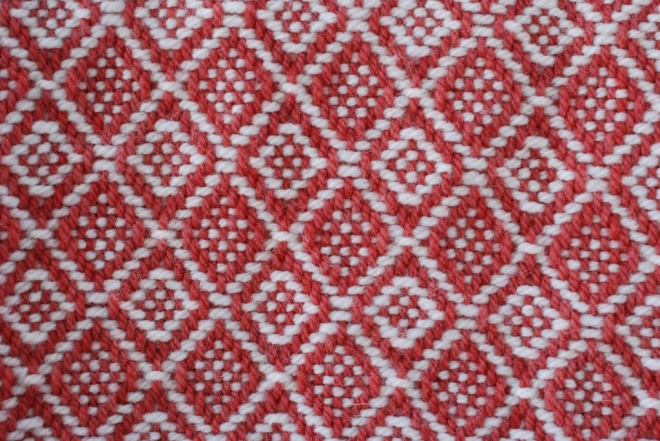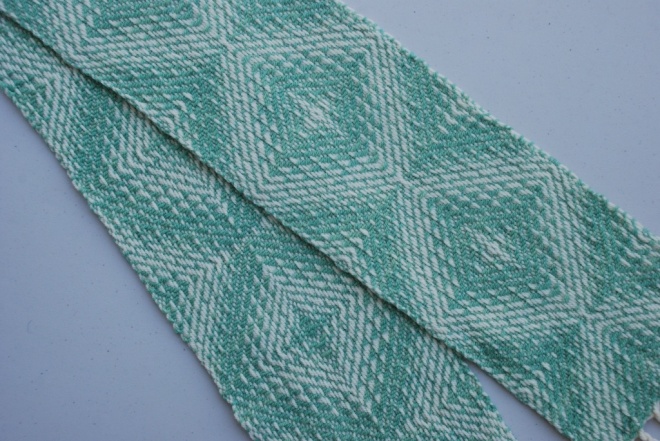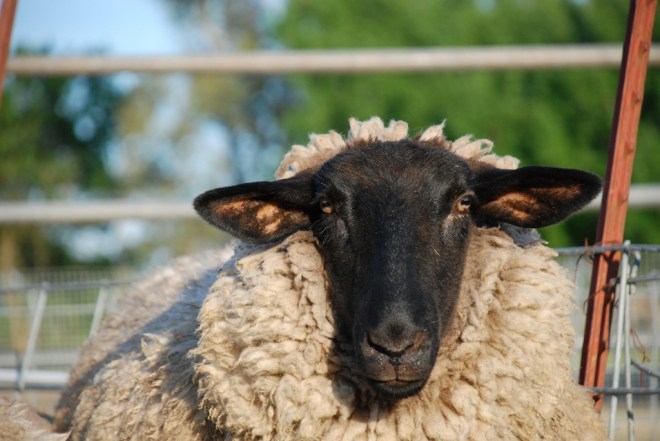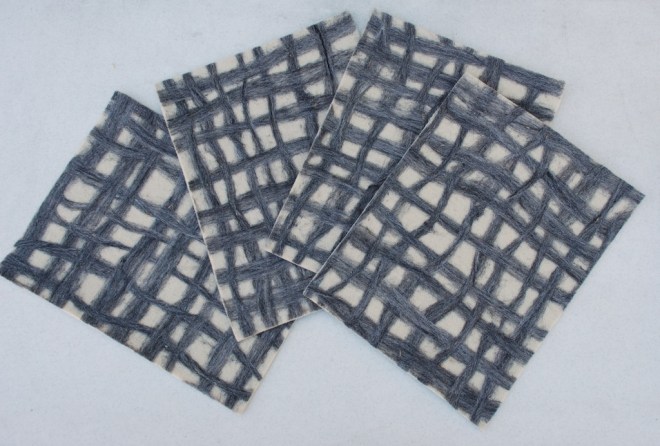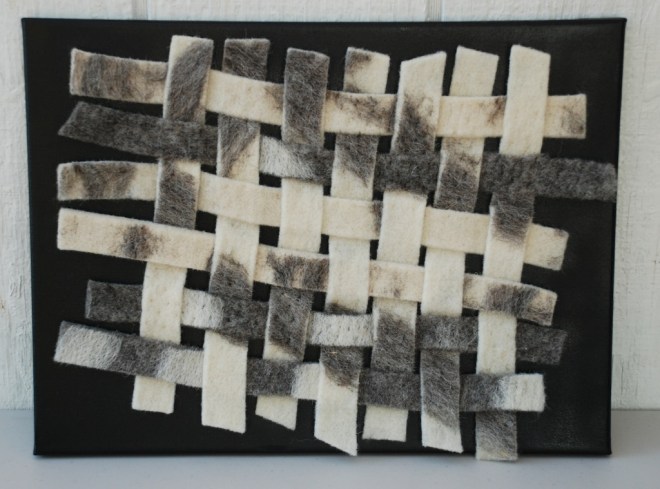This is actually the third post for Day 4 because there are too many photos…besides there are three very different experiences.
The goal of this trip was to be in Trinidad, Colorado for the opening of Women’s Work, an art show sponsored by Cowgirl Artists of America (CGA).
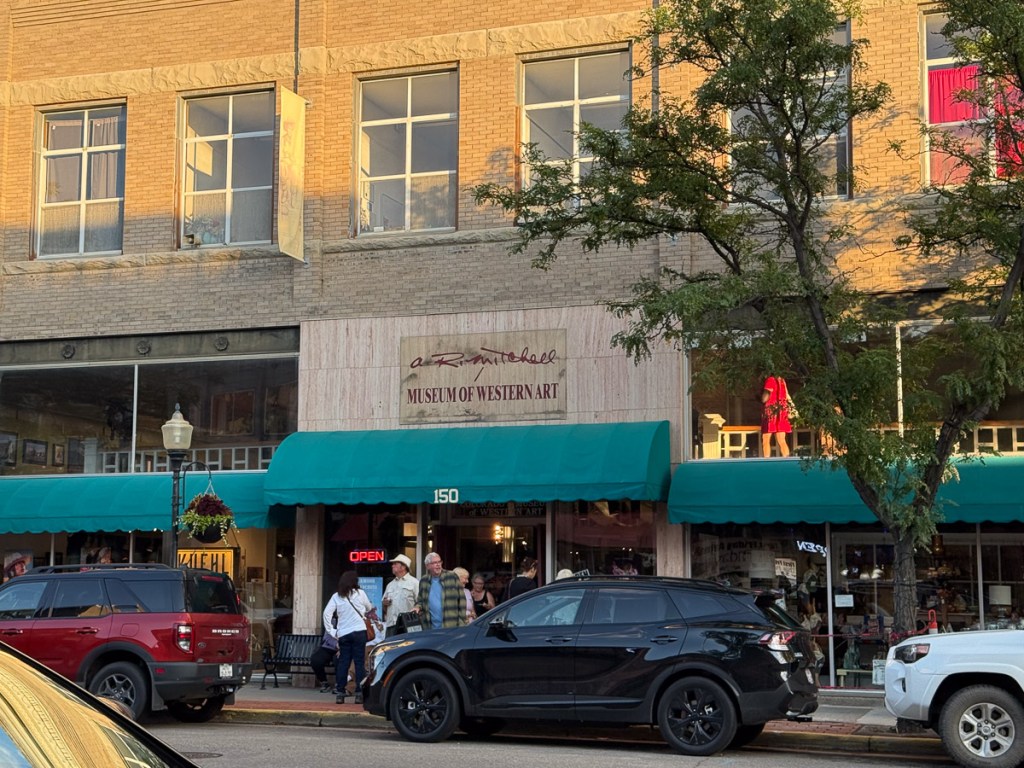
The show is at the A.R. Mitchell Museum of Western Art and will be open through September 20.
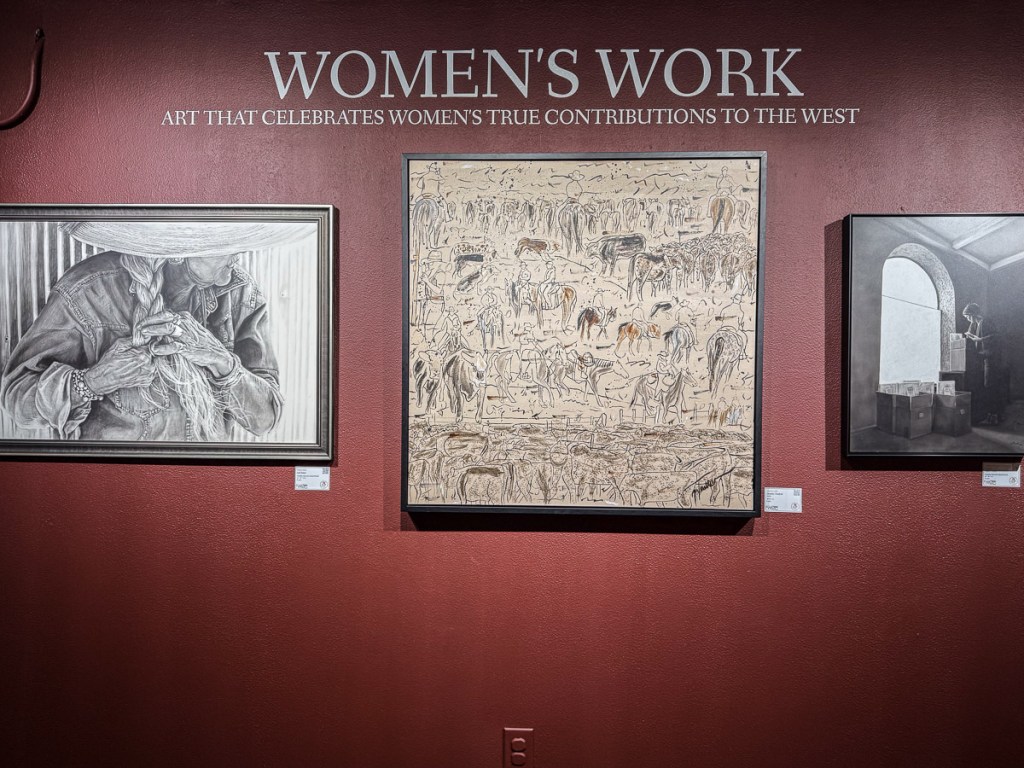
In 2024 we attended the opening of this show because I was a “farm partner”. The explanation and story is in this blog post from 2024. I think I did a better job of photographing last year’s show and sharing artist info in my blog. I took this quote from last year’s blog post, after copying it from the Cowgirl Artists’ website. From the website: “Celebrating the true contributions of Women in the American West…Much Western art is an ode to the work and contributions of men, while often limiting women to a single sphere, or pretty face. “Women’s Work,” a groundbreaking exhibition that teams artists up with women on working ranches, turns that notion on its head. By showcasing Western women as multi-faceted contributors to the Western way of life. Furthermore, Women’s Work aims to provide a platform for Indigenous women to authentically share their own stories, rooted in their intimate connections to culture and heritage. Traditional and fine artists are included, with all work on the theme of “Women’s Work.”
After seeing the show and talking to the organizer I decided to submit an entry for this year. Entries were due in the fall and, if accepted, work was to be completed in the spring 2025. I entered Year to Remember blankets using locally produced wool, and naturally dyed by me with plants grown on the farm. I could serve as my own “ranch partner”. I was accepted! Work was shipped to the show to arrive by mid-July.
The catalog of the show is at this link. There you can see all the pieces and details about work.

The Women’s Work show is upstairs in this building. The second floor is in a horseshoe shape over the lower floor. When I went upstairs I was immediately drawn to this display. Four artists worked together to put together the display.
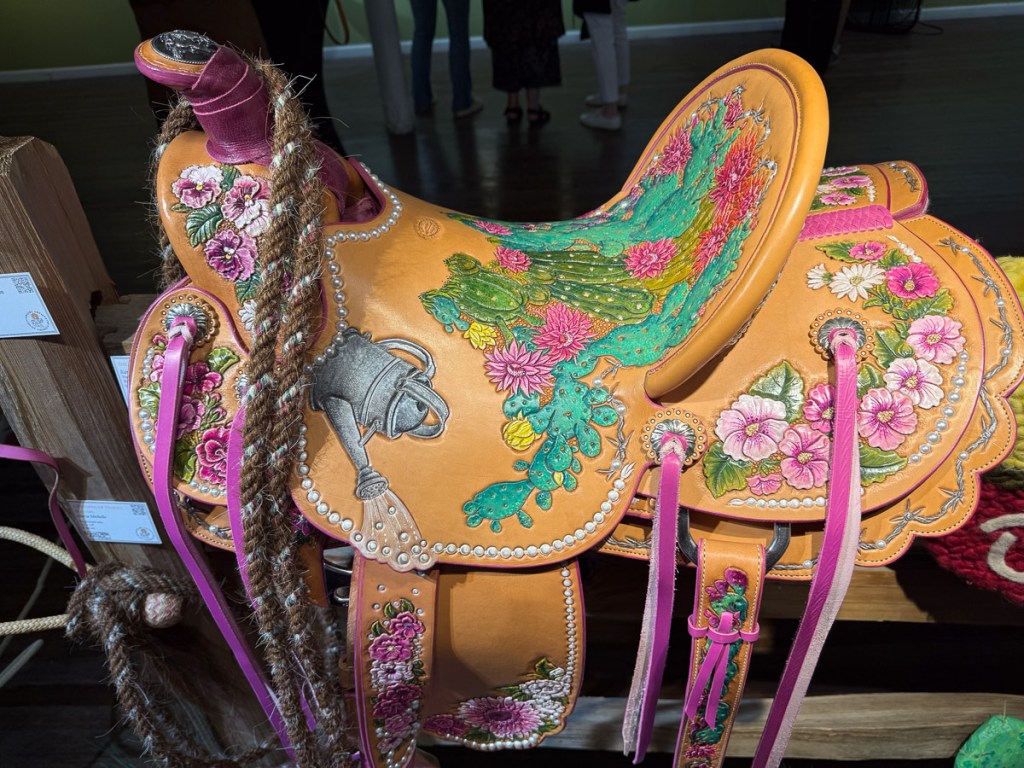
There is amazing detail on this saddle called She Who Made Me by Kari McCluey

This painting, CowGirl II – Securing a Win, is by Megan Wimberley, the woman behind Cowgirl Artists of America.

Bluebird Let Me Tag Along by Lisa Sorrell.

There are details about each piece in the catalog at the link above. There was by far more wall art than 3-D work, but it was difficult to get good photos of those. That’s why I recommend looking at the link.

These are my two blankets. Later I rearranged them so that the more colorful side is the one that shows. The blanket on the left indicates high temperatures for Trinidad, Colorado for 2024 and the one on the right is for Vacaville. The full year is portrayed following the stripes from one end to the other.
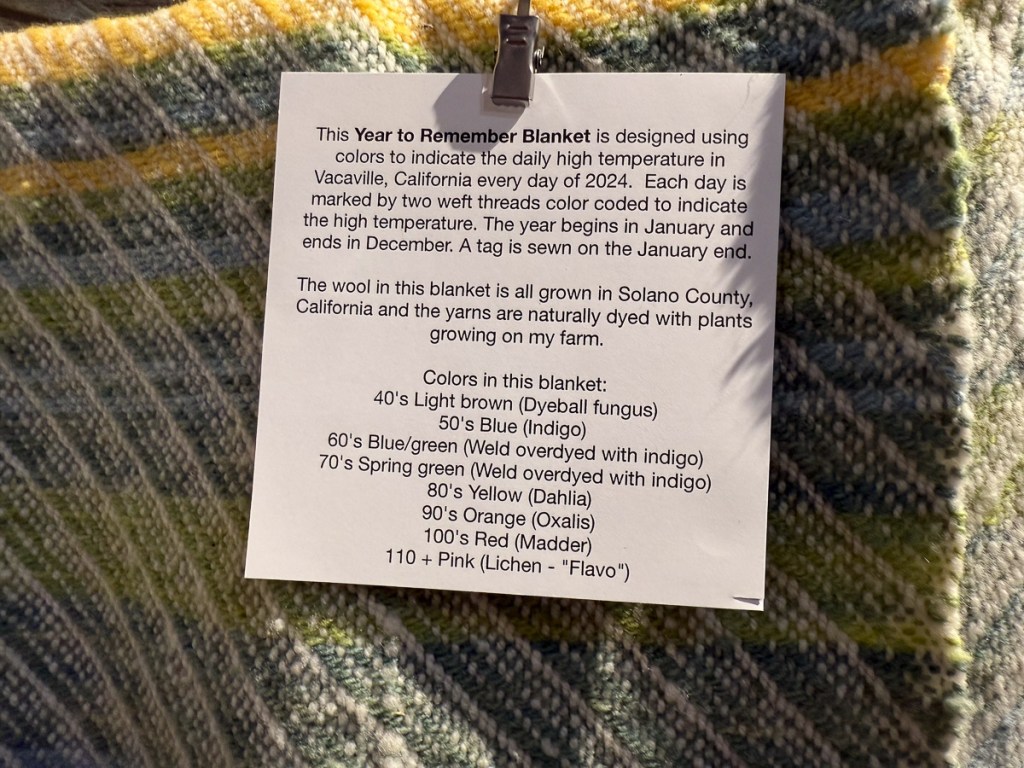
On Saturday I came prepared to include the info about the Year to Remember idea with color coding. I thought it would make the blankets more interesting (and more saleable). However, this is an art show and the person in charge wanted to keep the signage at a minimum. This info is in the catalog, so I took it off the blankets. I’m including it here as explanation…and because this is a plug for your custom Year to Remember blanket. I have a blanket warp on the loom now and can weave one. If these blankets don’t sell in this show they will be on my website after I get them back.


Dan took this photo.
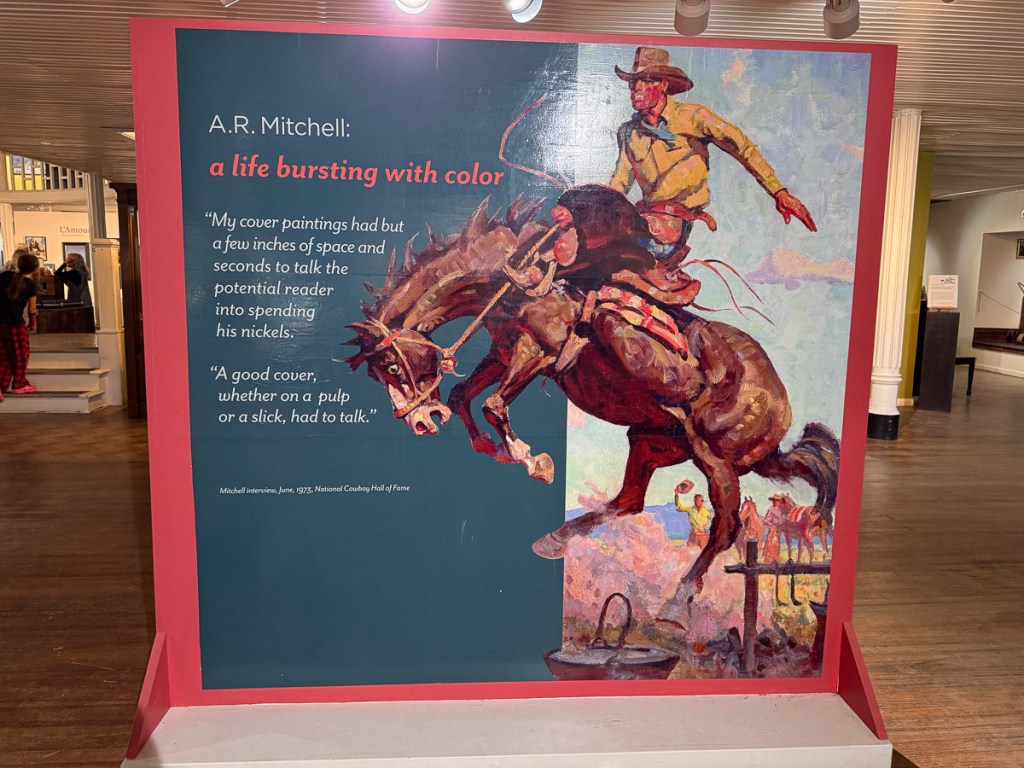
The A.R. Mitchelll Museum has a large display about Mitchell and his friends as well as contemporary western art for sale. From the Museum website: “During the 1870s and 1880s Trinidad was the headquarters of the largest cattle and sheep operation in the state of Colorado. A booming cow town filled with cowboys, cowhands and ranchers, Trinidad’s streets and neighboring towns were home to the horses, cattle and beloved cowboys and cowgirls that A.R. Mitchell would paint and immortalize throughout his career.”
I am already over my self-imposed limit of 10 photos, but I want to continue the story so I can blog about things at home.
On Saturday there was a luncheon provided by CGA to be followed by an artists’ talk. I had been asked to be one of the panel. Before the luncheon we wandered around this block of Trinidad.

I got a kick out of this design. That’s a real truck, not painted.
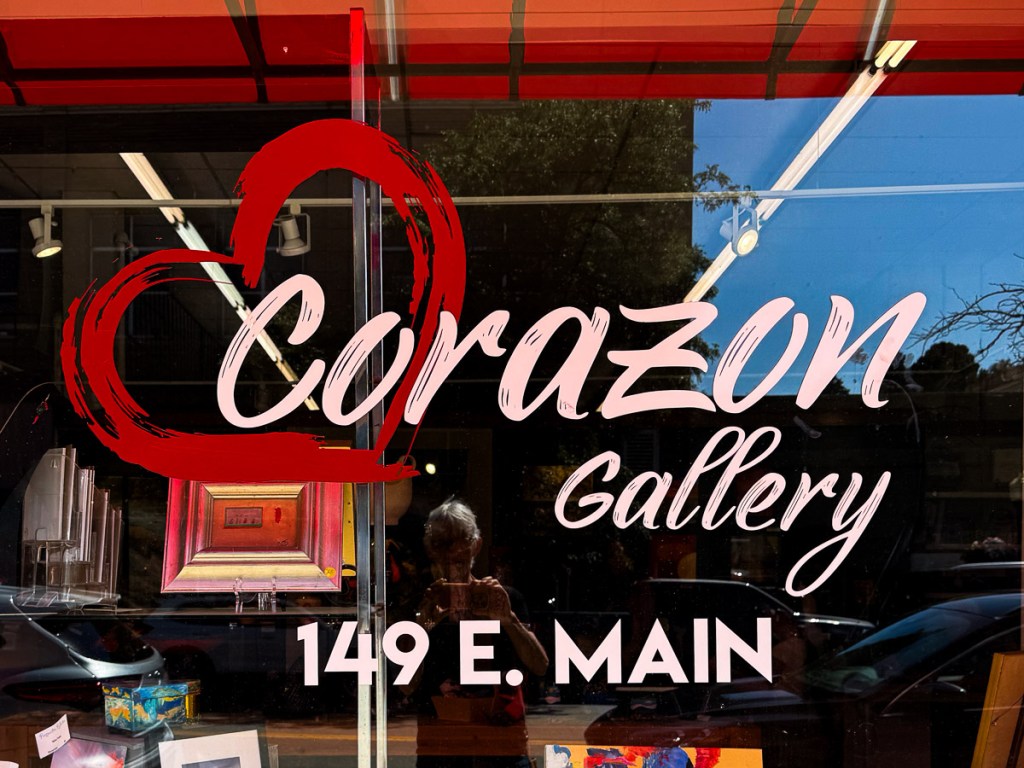
We stopped in the Corazon Gallery across the street from the A.R. Mitchell Museum. I was interested in this because it is an artists’ coop as is The Artery where I sell in Davis, California. Here’s a “small world” experience. We wandered through the gallery and I noticed a landscape photograph with the photographer’s name Joe Coca. I knew that name. Having subscribed to Handwoven magazine since the first issue in fall, 1979 I was very familiar with photography by Joe Coca. I wondered if he might be the same person because Handwoven magazine was based in Colorado. We started up a conversation with the person staffing the store on that day. I assume it is like The Artery where all of us artists take turns being shopkeepers when the store is open. I said we were in town for the show across the street and I had entered handwoven pieces. It turns out that I was talked with Joe Coca! We talked awhile longer. He worked with Interweave Press for years and has been all over the world as a photographer. Joe’s website states that he is semi-retired, but it is worth looking at the website to see some stunning photography.
Back to the show!

After the luncheon awards were announced. There was a winner and an honorable mention in the 2-D and 3-D categories. I was so surprised to get the 3-D Honorable Mention!

The people selected for the panel discussion were all artists who were able to fill the role of their own “ranch partner”. Megan, left, had prepared questions for all of us to answer. It was a fun experience and I was very interested to hear the stories of the other women. The other women are all cattle ranchers. Megan asked questions about how we got started, how we integrate artwork with our daily lives as ranchers (I call myself a farmer, but that’s another story– what is the difference between a farmer and a rancher?), do we have issues with gender expectations, recommendations for young people just starting, etc. One difference that I thought about later is that although we all talked about seasonality of ranching/farming, I think I am the only one who direct markets. In other words, I don’t load all my lambs on a truck and send them off to market and I don’t take my fiber, yarn, and handwoven to a retail store and it’s gone. I have interaction with all the customers whether I’m selling lambs for meat or for breeding flocks or selling all the fiber products. I spend time at the computer on social media letting the world know I’m here (including this blog–please share!), time (not enough) working my website, teaching fiber arts, working at The Artery, and attending fiber shows. That doesn’t mean any of us have more or less work than the other. It’s just different. A theme in the discussion was that there is Never enough time for all of it.
Dan had my camera and recorded some of the comments. I haven’t had time to listen yet.
After this discussion we got on the road and headed north to Colorado Springs where Dan’s brother and sister live.
To be continued…

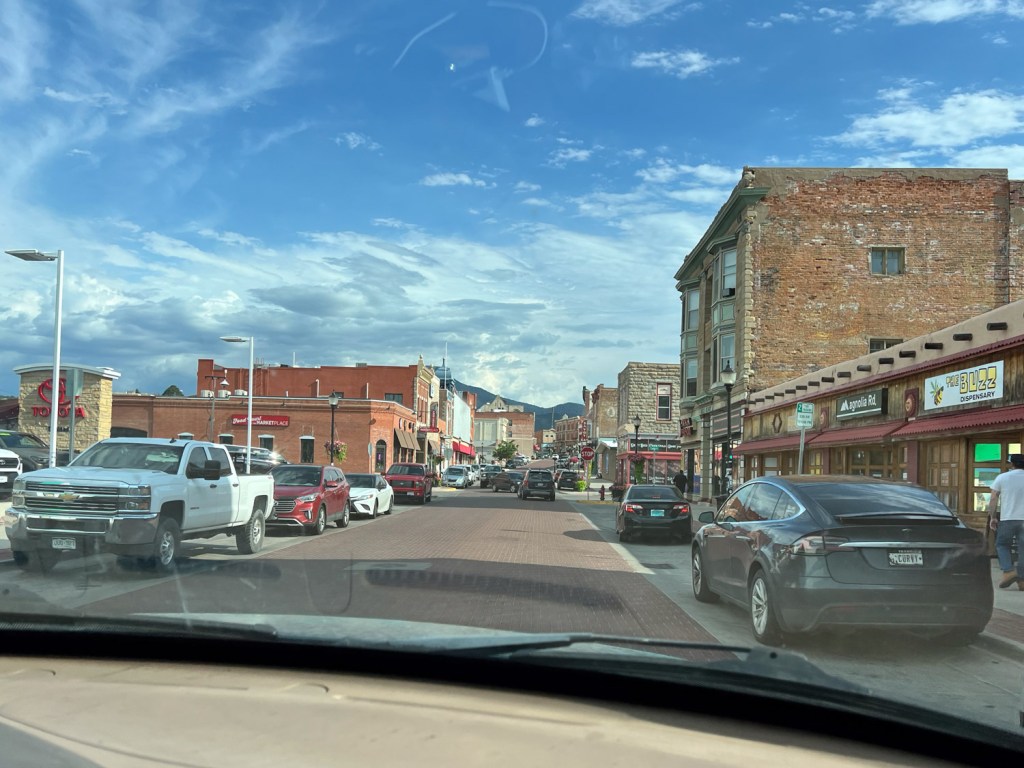



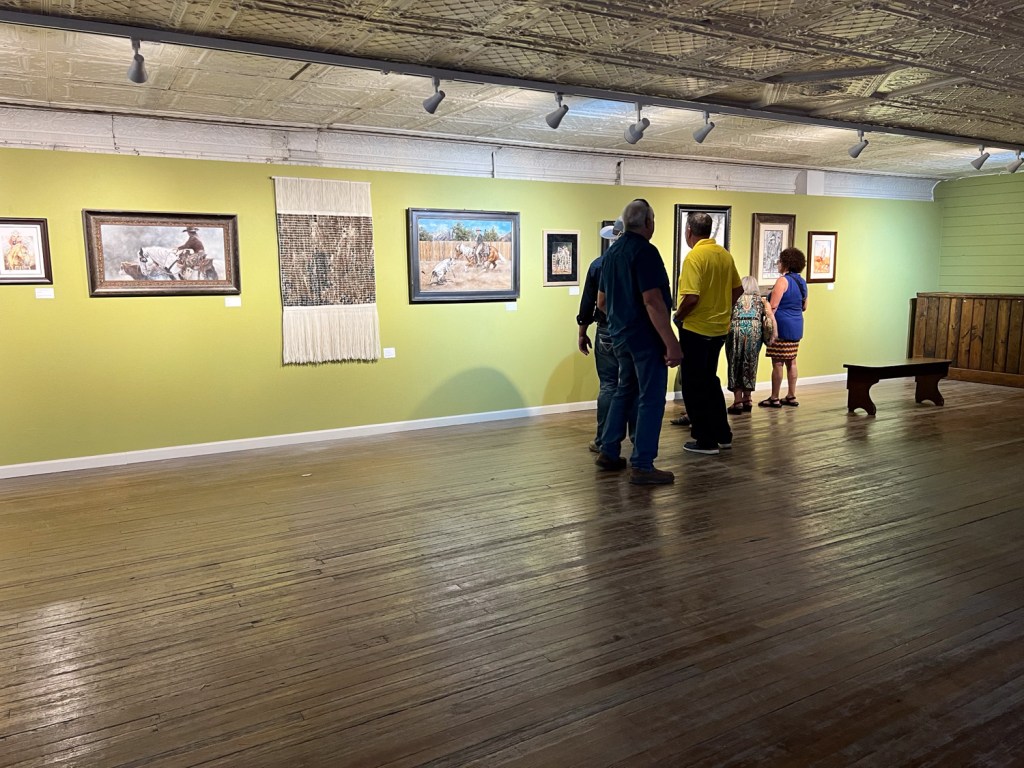
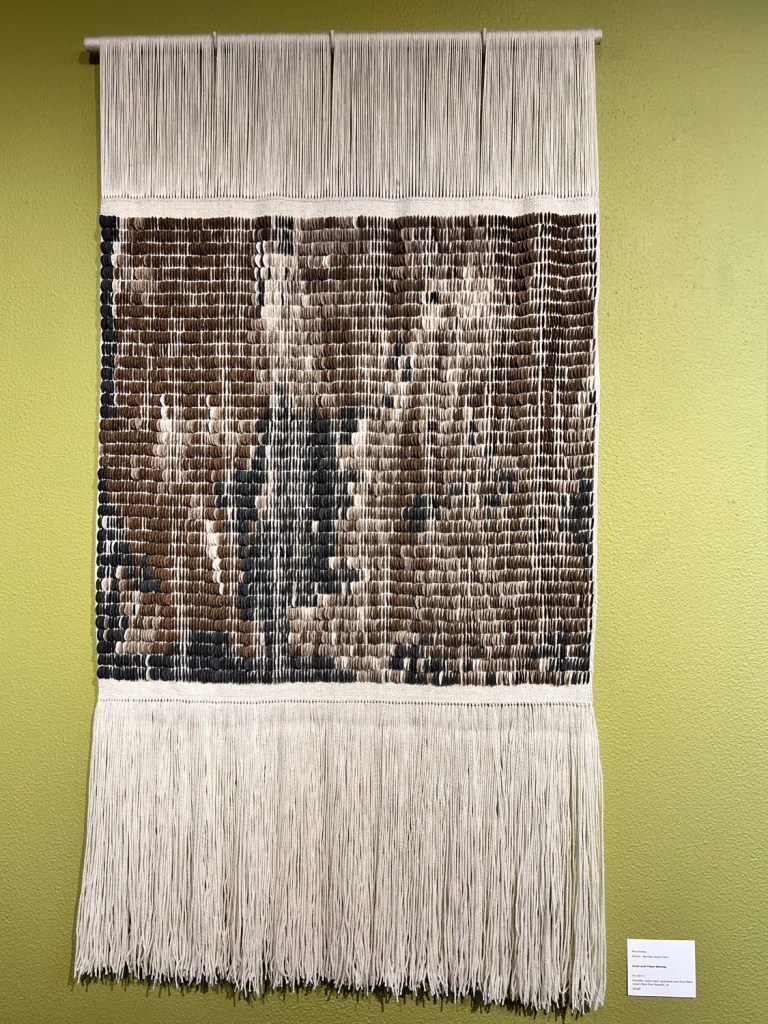
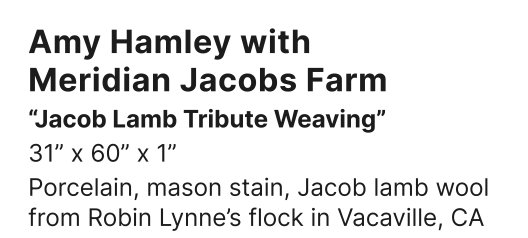
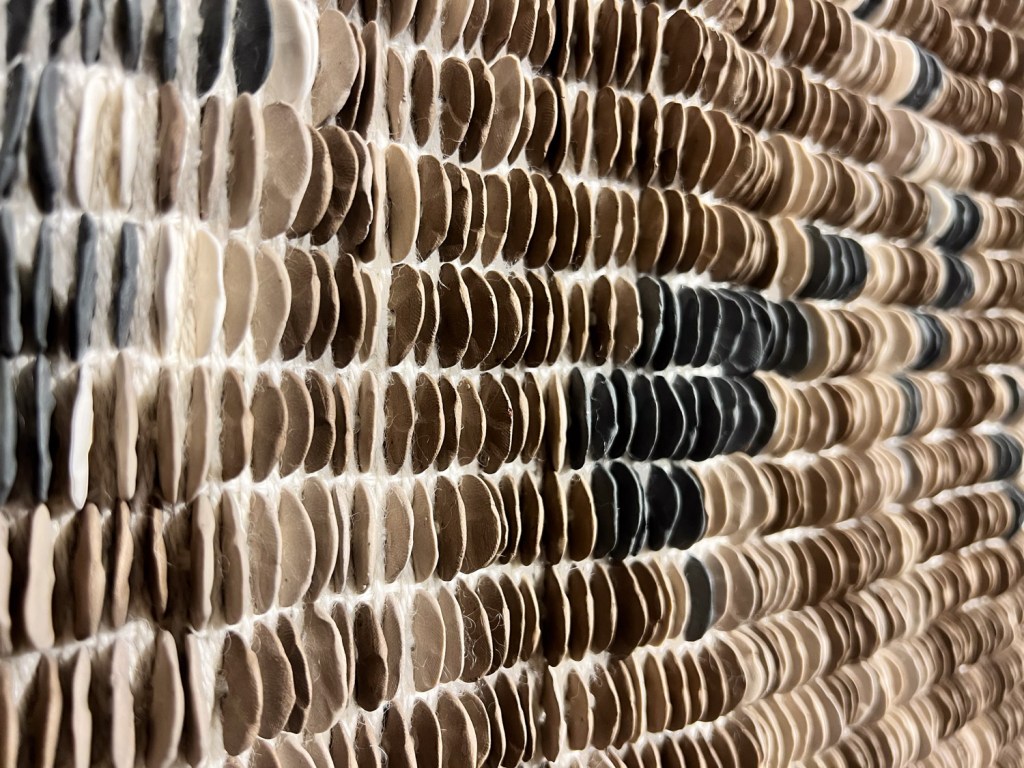



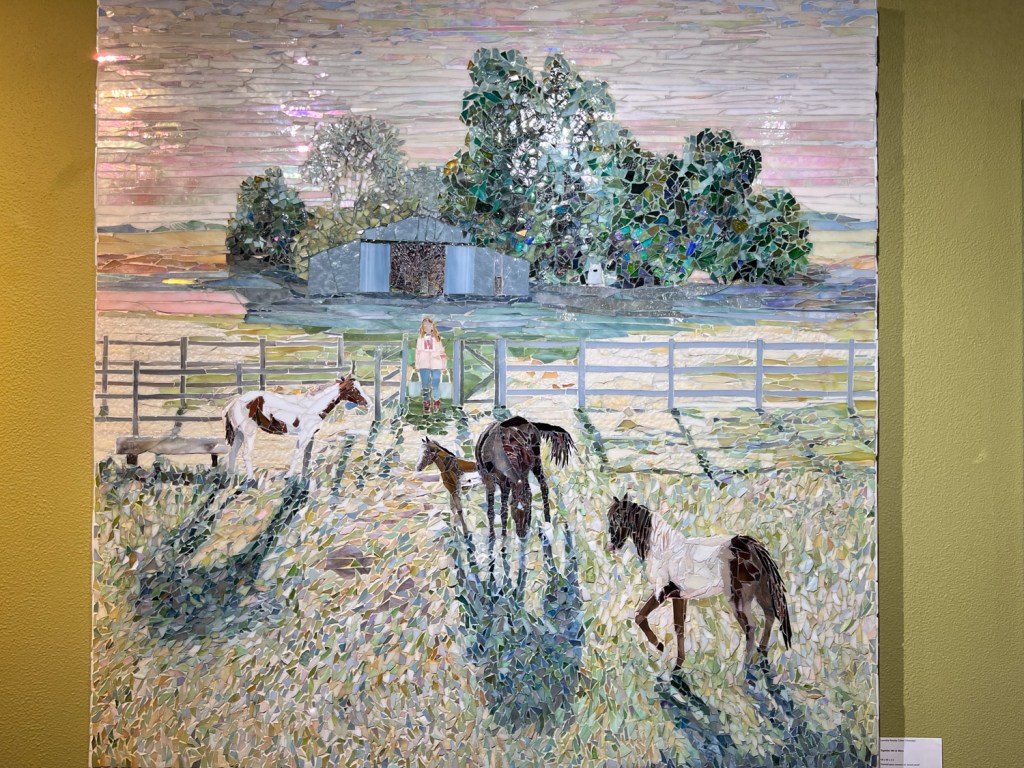





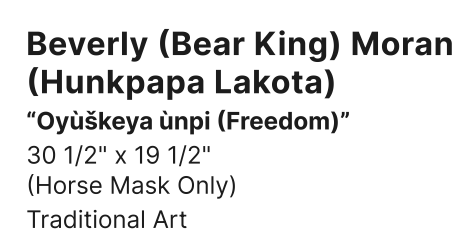
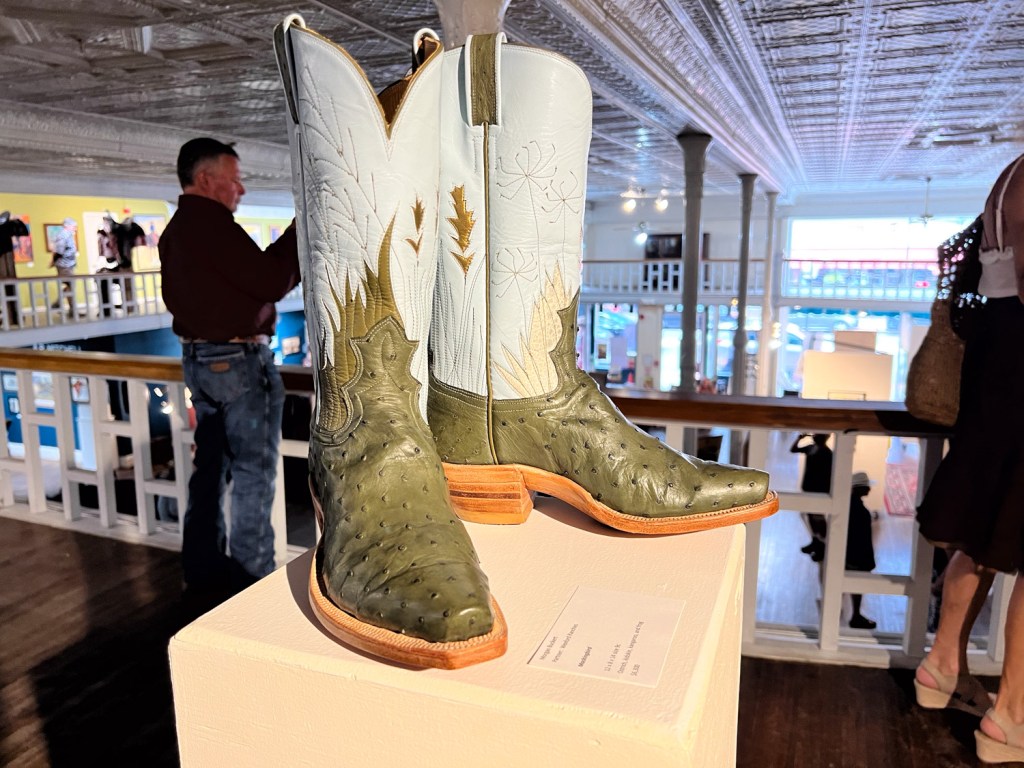
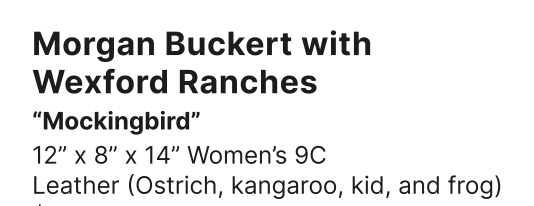


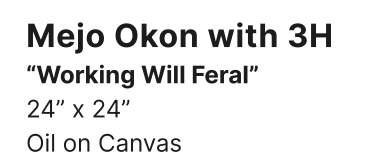

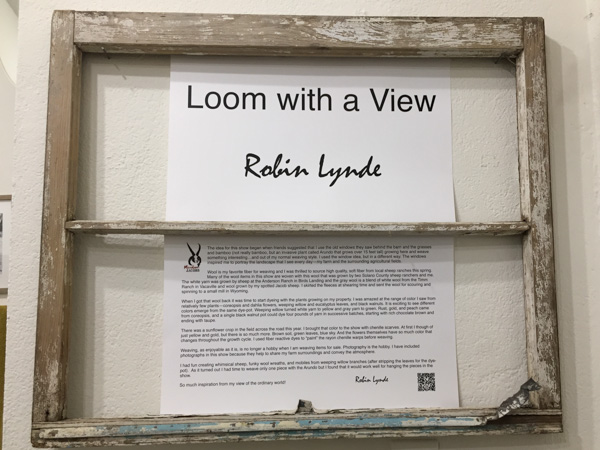 As I said in one of the previous posts this theme started with the idea of using the old windows that were around here. As you enter the gallery you see the title and the Artist’s Statement. If you want to read that click here.
As I said in one of the previous posts this theme started with the idea of using the old windows that were around here. As you enter the gallery you see the title and the Artist’s Statement. If you want to read that click here.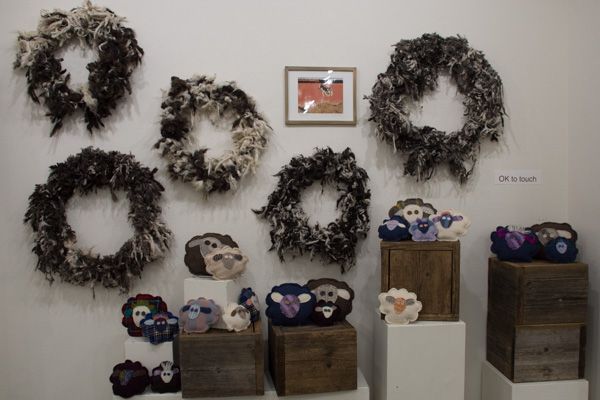 This is the wall to the right…
This is the wall to the right…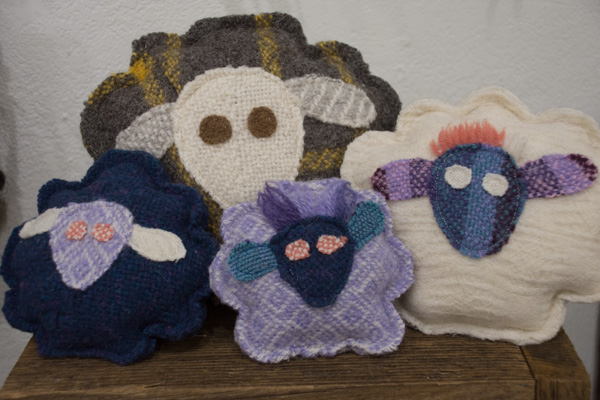 …and these are some of the sheep.
…and these are some of the sheep.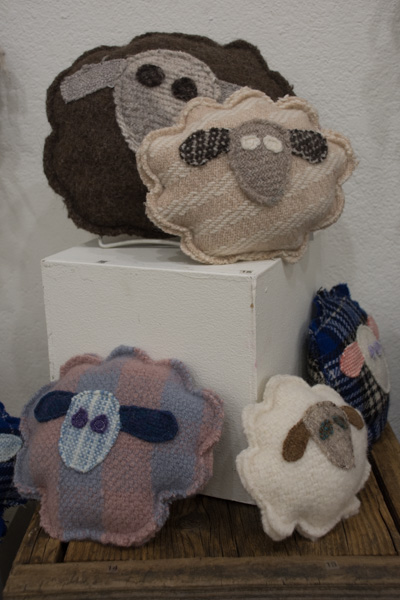 More sheep.
More sheep.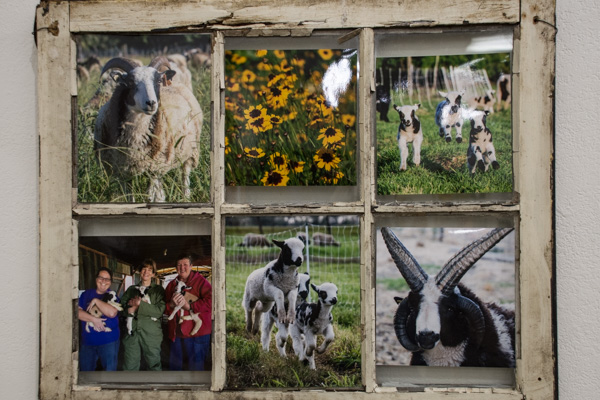 Continuing around the gallery there is this collection of photos. I used two of these six-pane windows to display photos and give a feel for the farm. These are not for sale because they are too rotten (people have asked) but some of the photos have been matted or framed and are for sale.
Continuing around the gallery there is this collection of photos. I used two of these six-pane windows to display photos and give a feel for the farm. These are not for sale because they are too rotten (people have asked) but some of the photos have been matted or framed and are for sale.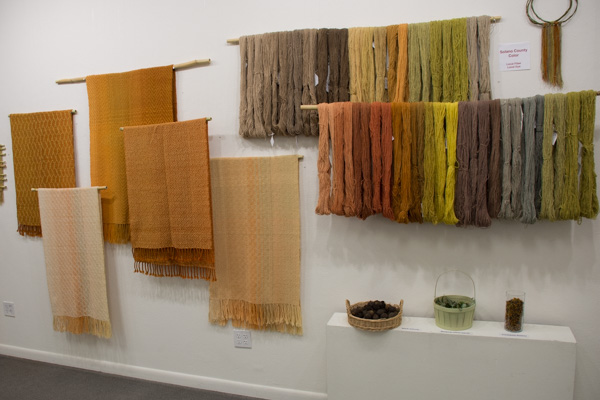 This is the Solano Colors wall and the yarns are the
This is the Solano Colors wall and the yarns are the 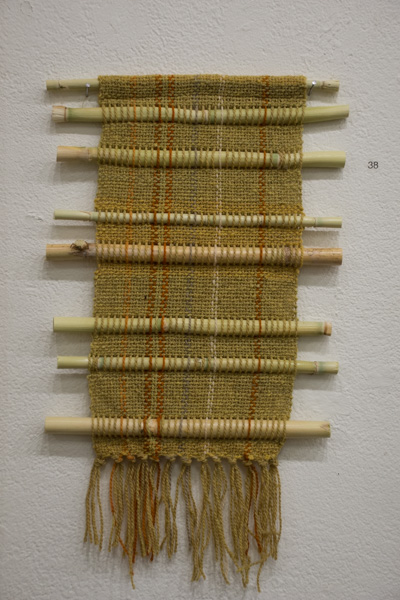 If you look at the previous photo again you’ll see that the shawls and the yarn are hanging on what looks like bamboo. I decided to use the Arundo (an invasive species that grows on our north border and had big hollow stalks like bamboo) for hanging the pieces in the show. It was in keeping with the rest of the props (stuff found on the farm), I have an infinite supply of it, I could cut it to any size, and it is free. The perfect solution! Originally I had planned to use the Arundo for weaving, but I just didn’t get to it. On the morning I was to set up the show I got up early with a lot on my mind. I got out the loom that I had already warped for this and I wove this piece. It inspires me to do more because I think it is very cool.
If you look at the previous photo again you’ll see that the shawls and the yarn are hanging on what looks like bamboo. I decided to use the Arundo (an invasive species that grows on our north border and had big hollow stalks like bamboo) for hanging the pieces in the show. It was in keeping with the rest of the props (stuff found on the farm), I have an infinite supply of it, I could cut it to any size, and it is free. The perfect solution! Originally I had planned to use the Arundo for weaving, but I just didn’t get to it. On the morning I was to set up the show I got up early with a lot on my mind. I got out the loom that I had already warped for this and I wove this piece. It inspires me to do more because I think it is very cool.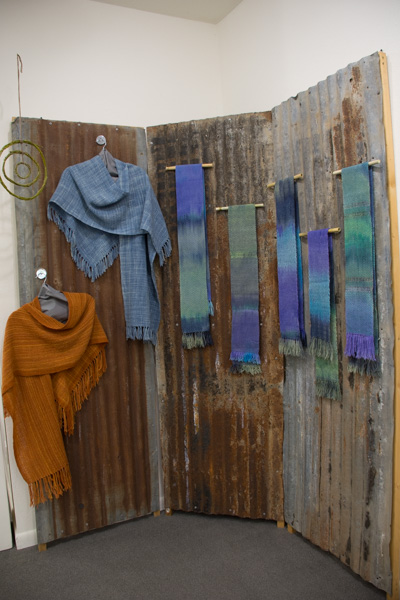 Moving on around the room this is the next grouping. Those scarves were woven on a space-dyed warp that I dyed a few years ago and found in a box on the shelf. Do you see something hanging to the left?
Moving on around the room this is the next grouping. Those scarves were woven on a space-dyed warp that I dyed a few years ago and found in a box on the shelf. Do you see something hanging to the left? I wanted to do something interesting with the weeping willow branches after stripping the leaves for the dye pots. I tried weaving with them but I think I like this mobile best.
I wanted to do something interesting with the weeping willow branches after stripping the leaves for the dye pots. I tried weaving with them but I think I like this mobile best.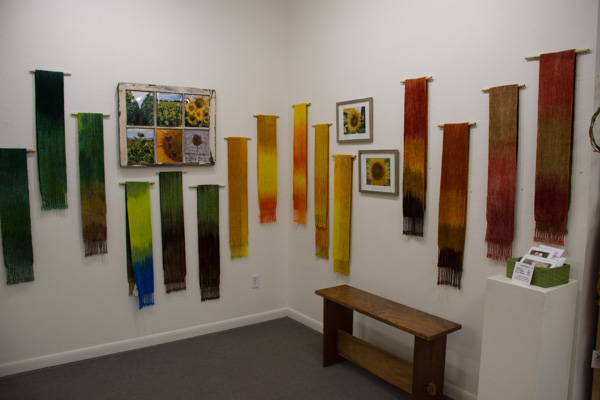 The Sunflower wall is around the corner. These are rayon chenille scarves in the colors of the sunflower field that was Across the Road last summer. I didn’t just stick with the yellows and oranges of the flowers but included all the colors of the fields.
The Sunflower wall is around the corner. These are rayon chenille scarves in the colors of the sunflower field that was Across the Road last summer. I didn’t just stick with the yellows and oranges of the flowers but included all the colors of the fields.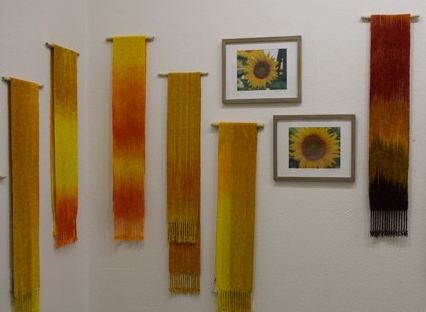 Here is a closer view of the flower scarves.
Here is a closer view of the flower scarves.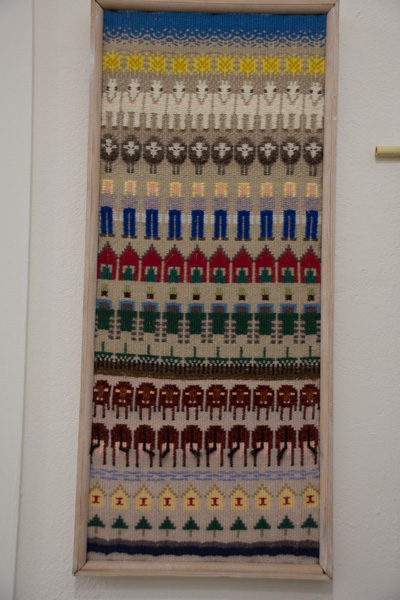 In addition to the window pane photo collage, I included this piece that is not for sale. I wove this years ago when we lived and worked on our family dairy.
In addition to the window pane photo collage, I included this piece that is not for sale. I wove this years ago when we lived and worked on our family dairy.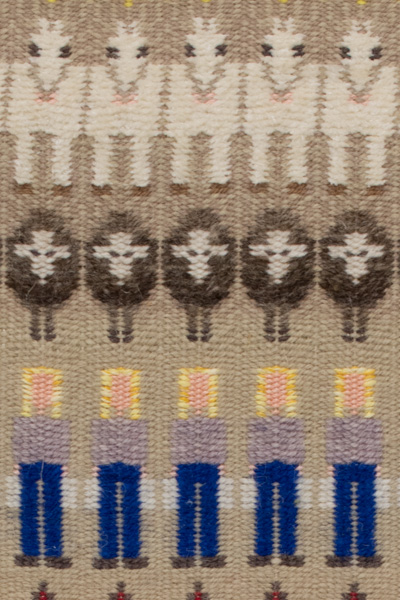 This close-up includes my daughter carrying milk buckets, my sheep, and our pony.
This close-up includes my daughter carrying milk buckets, my sheep, and our pony.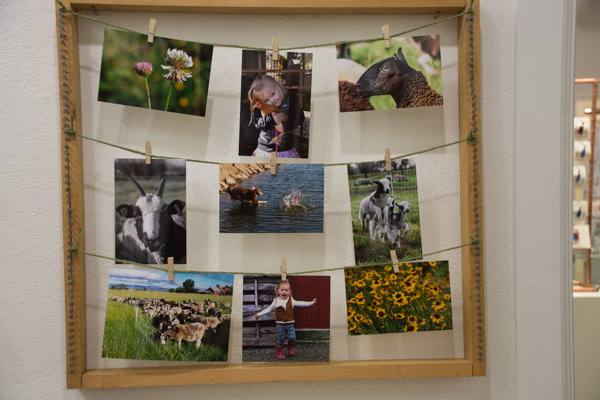 Here is another farm photo collection.
Here is another farm photo collection.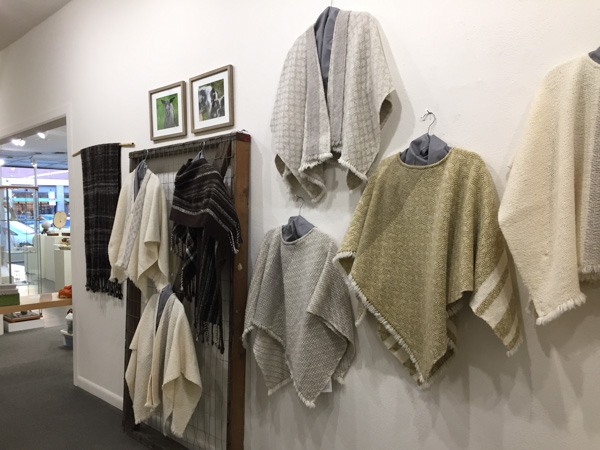 These ponchos and ruanas use the same yarns as the Solano Colors wall, but mostly in natural sheep colors. There are also a couple of handspun Jacob pieces here.
These ponchos and ruanas use the same yarns as the Solano Colors wall, but mostly in natural sheep colors. There are also a couple of handspun Jacob pieces here.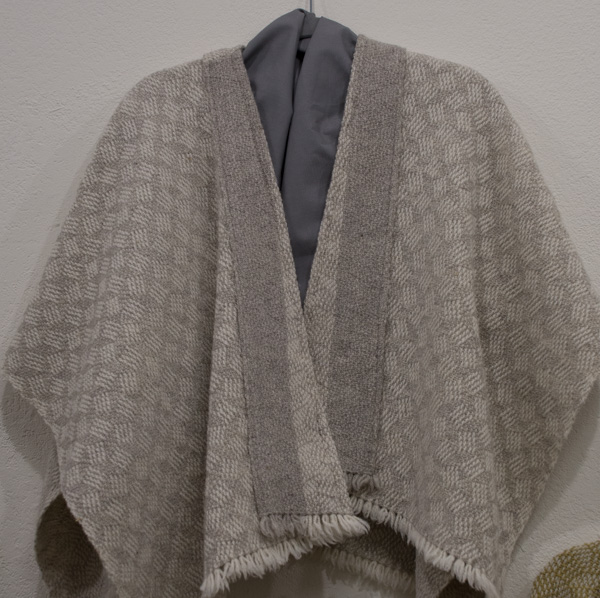 Close up of a ruana.
Close up of a ruana.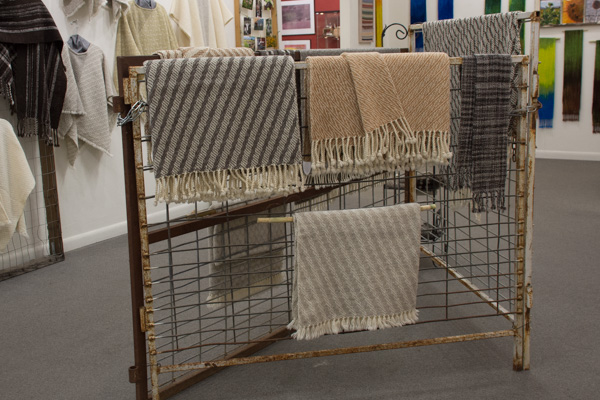 The display in the center of the room is really panels out of my sheep trailer. I used them to hang my blankets and some scarves.
The display in the center of the room is really panels out of my sheep trailer. I used them to hang my blankets and some scarves.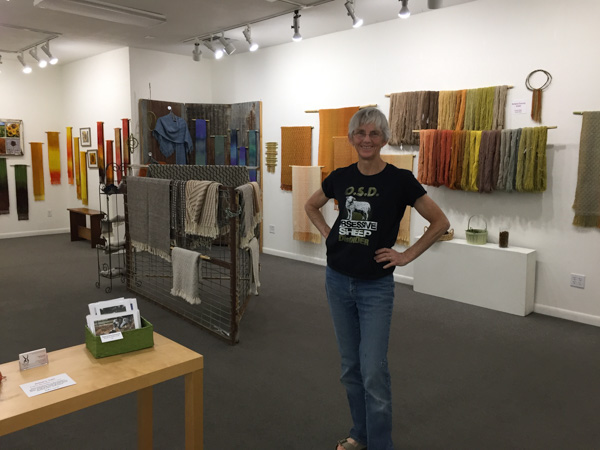 Here is an overall view of the room…
Here is an overall view of the room…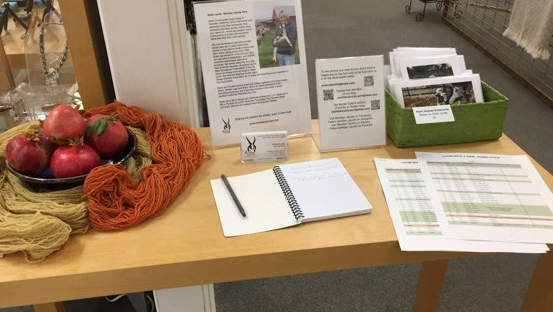 …and this is the table in the doorway when you come in. The notebook is for visitors’ comments. I’d love to see your comments as well.
…and this is the table in the doorway when you come in. The notebook is for visitors’ comments. I’d love to see your comments as well.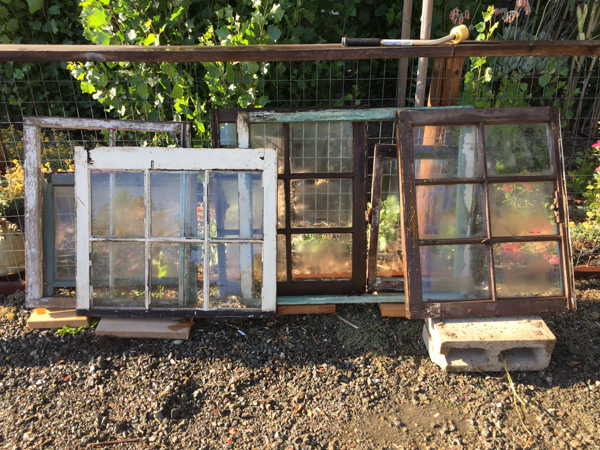 Friends (Lisa and Dona?) said “you should use those old windows that are in back”. They were thinking that I could weave using the windows as weaving frames. They like that sort of thing. I like it too, but I haven’t actually done much of it. My weaving is more functional than decorative–like blankets, shawls, and scarves. I admire things to hang on the wall, but my house has hardly any wall space, and in my world things that hang on the wall just get covered with dust and cobwebs. Still, one point of doing a show is to move outside what is your same-old-stuff.
Friends (Lisa and Dona?) said “you should use those old windows that are in back”. They were thinking that I could weave using the windows as weaving frames. They like that sort of thing. I like it too, but I haven’t actually done much of it. My weaving is more functional than decorative–like blankets, shawls, and scarves. I admire things to hang on the wall, but my house has hardly any wall space, and in my world things that hang on the wall just get covered with dust and cobwebs. Still, one point of doing a show is to move outside what is your same-old-stuff.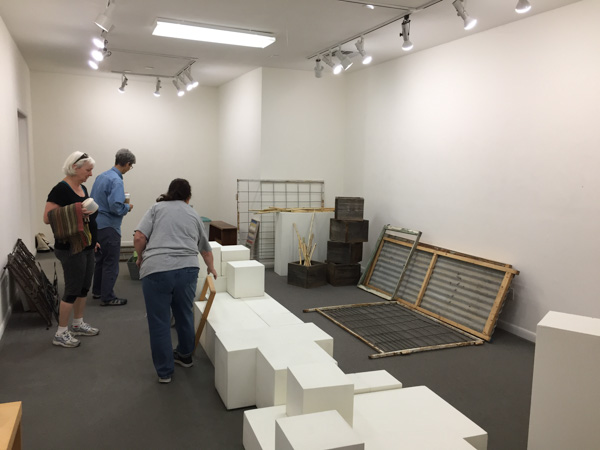 Wednesday, October 25, 2017. That date was stuck in my head. I had to be Ready. My friends showed up when the gallery opened at 9:30 and we unloaded the truck. All those white cubes were in the gallery from the previous show. The first decision to be made was which cubes to leave for my show. The Artery Display Committee needs to know how many they can use for the other store displays, but the person doing the gallery show gets first choice.
Wednesday, October 25, 2017. That date was stuck in my head. I had to be Ready. My friends showed up when the gallery opened at 9:30 and we unloaded the truck. All those white cubes were in the gallery from the previous show. The first decision to be made was which cubes to leave for my show. The Artery Display Committee needs to know how many they can use for the other store displays, but the person doing the gallery show gets first choice.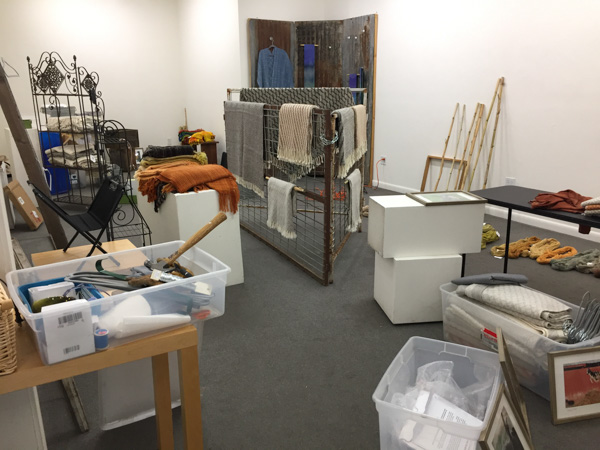 I wasn’t really sure but narrowed it down to Not Very Many, keeping some of the larger ones.
I wasn’t really sure but narrowed it down to Not Very Many, keeping some of the larger ones.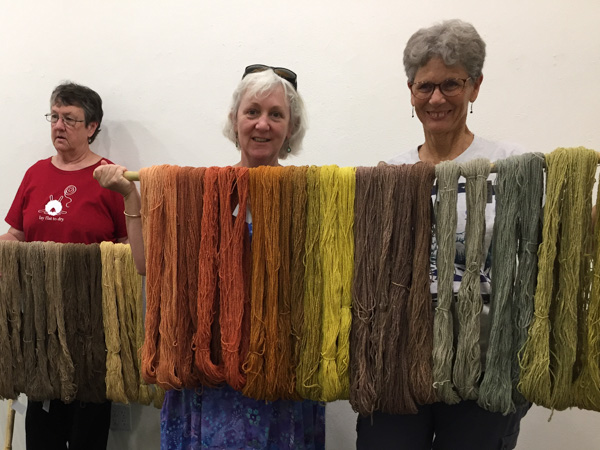 Organizing by color.
Organizing by color.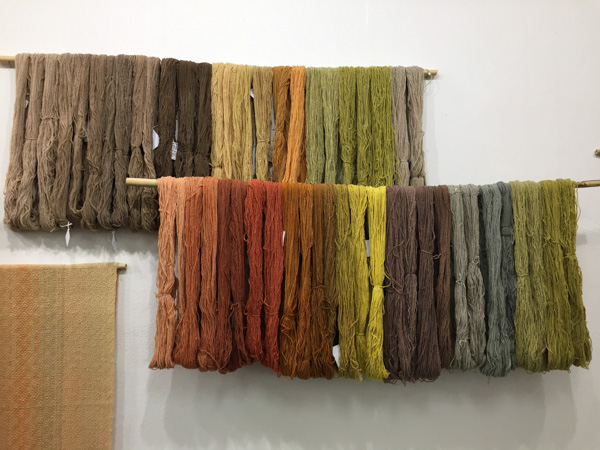
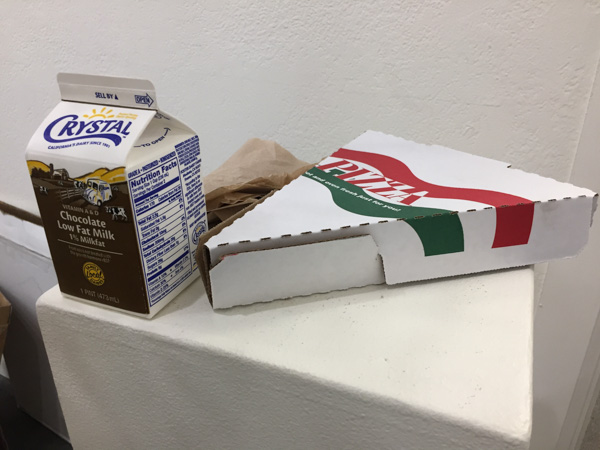 Half way through the day I needed to get my signs printed for the entry. My friends were going to go get lunch and I asked them to bring back a slice of pizza. They know me well. It was touching that they brought back my favorite beverage, but saved for special stress-invoking occasions like being at the fair all day.
Half way through the day I needed to get my signs printed for the entry. My friends were going to go get lunch and I asked them to bring back a slice of pizza. They know me well. It was touching that they brought back my favorite beverage, but saved for special stress-invoking occasions like being at the fair all day.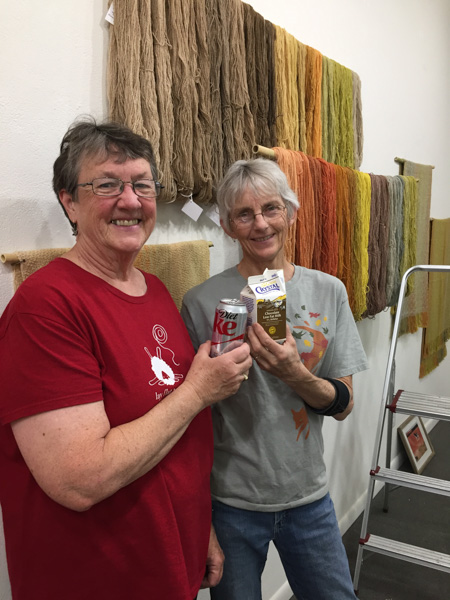 Lunch break.
Lunch break.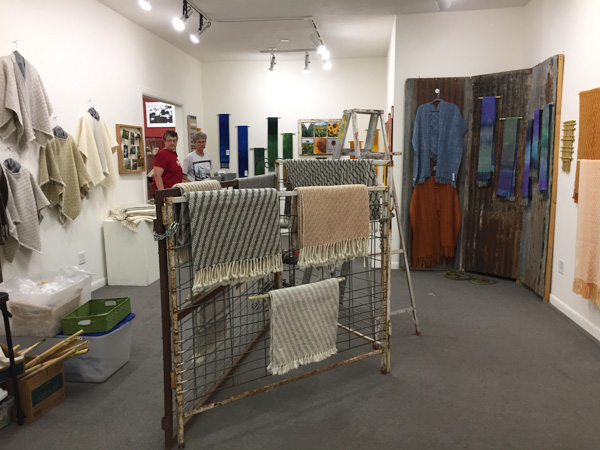 As Dona and Mary left at 5-ish I think they wondered if I’d spend the night there.
As Dona and Mary left at 5-ish I think they wondered if I’d spend the night there.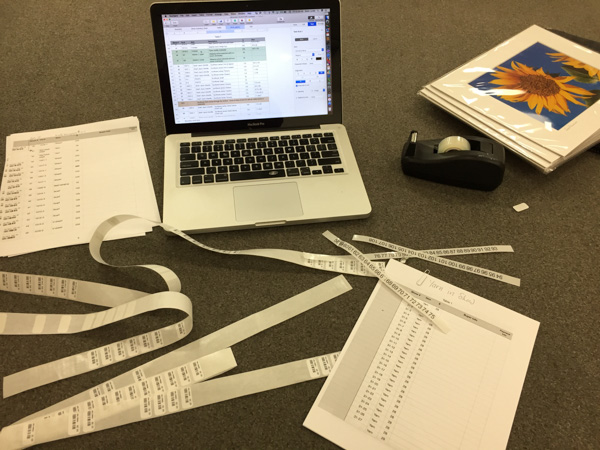 Keeping track of all the pieces in the show by my inventory number and the show number (not the same), entering pieces into the Artery computer, applying barcodes to the tags, applying bar codes to the sales list at the desk, applying sticky numbers to the wall for each piece. I could have used a chocolate milk. I finished up at about 1:30 on Friday.
Keeping track of all the pieces in the show by my inventory number and the show number (not the same), entering pieces into the Artery computer, applying barcodes to the tags, applying bar codes to the sales list at the desk, applying sticky numbers to the wall for each piece. I could have used a chocolate milk. I finished up at about 1:30 on Friday.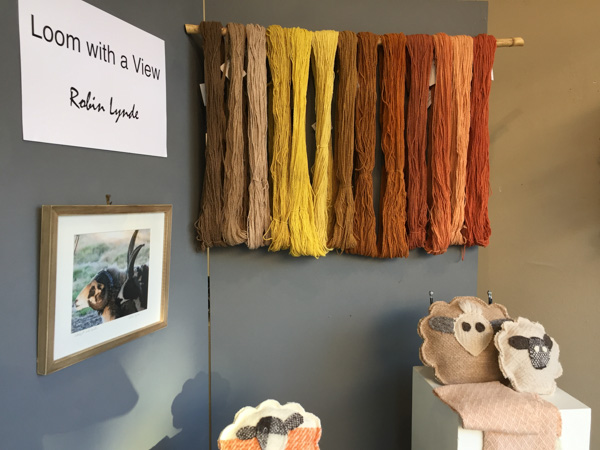 This is the display in the front window.
This is the display in the front window.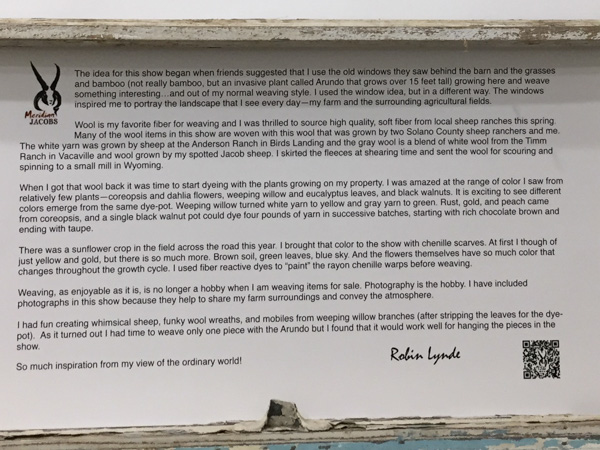













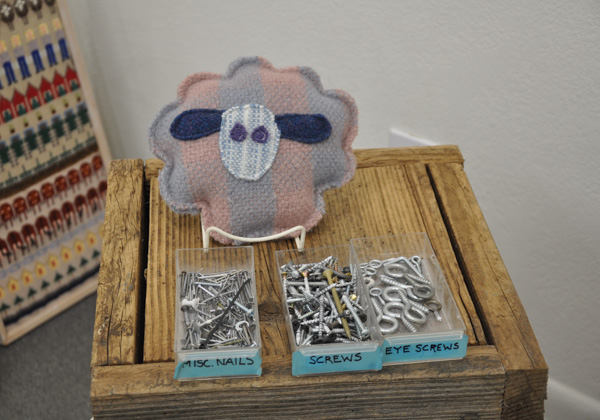











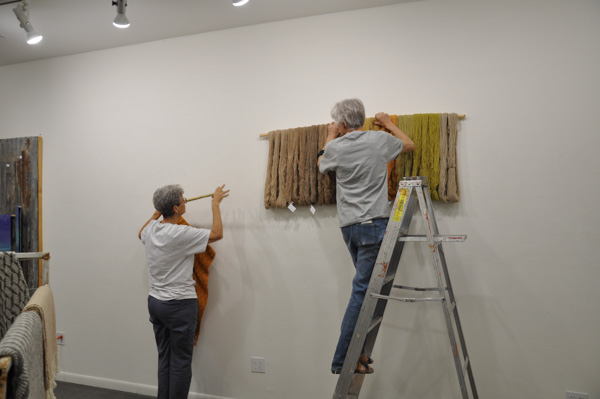 Putting up the Solano Colors wall.
Putting up the Solano Colors wall.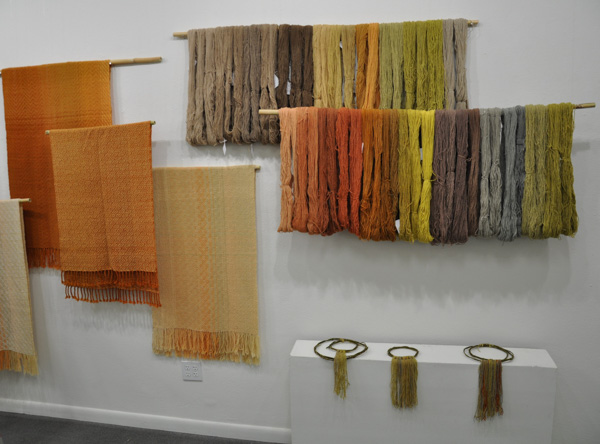
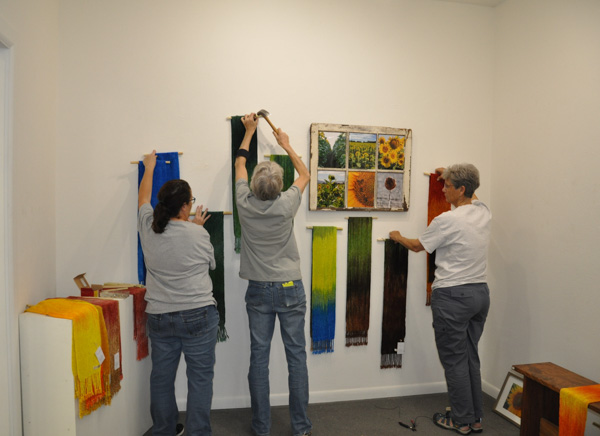 Working on the Sunflower Wall.
Working on the Sunflower Wall.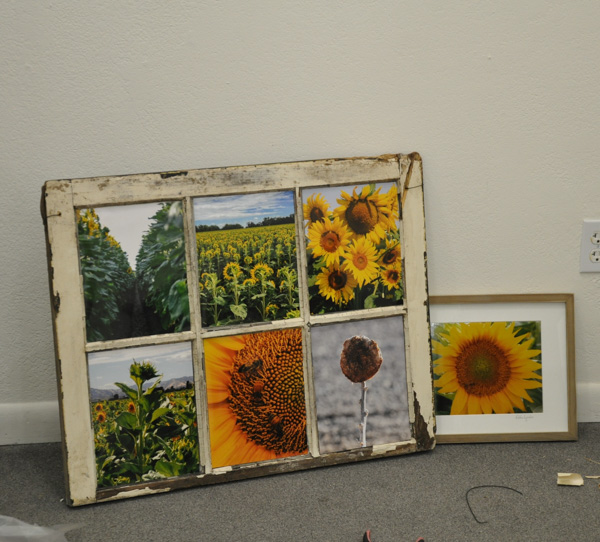


























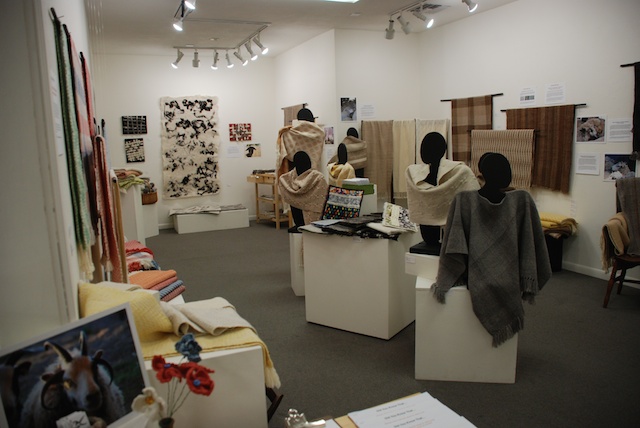 into the corner at the end of the room. I didn’t finish until the next day.
into the corner at the end of the room. I didn’t finish until the next day.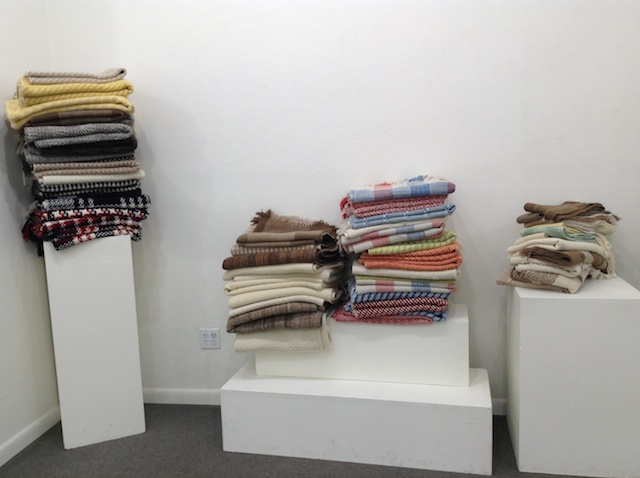 This is some of the blankets all tagged and ready to show again.
This is some of the blankets all tagged and ready to show again.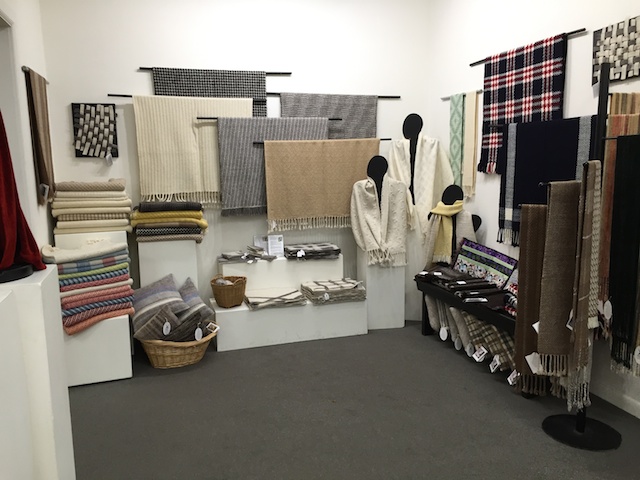
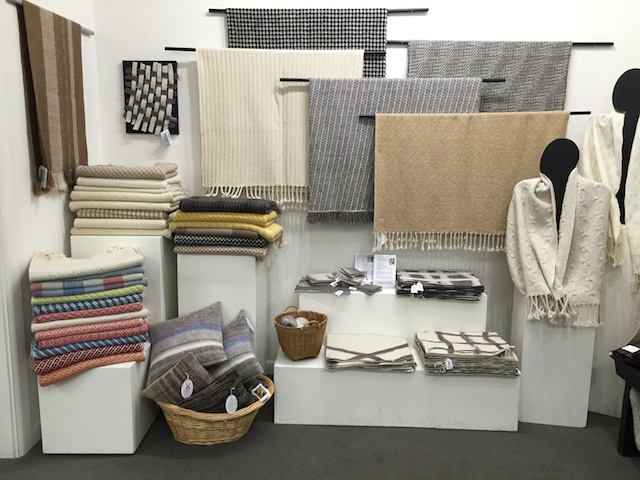
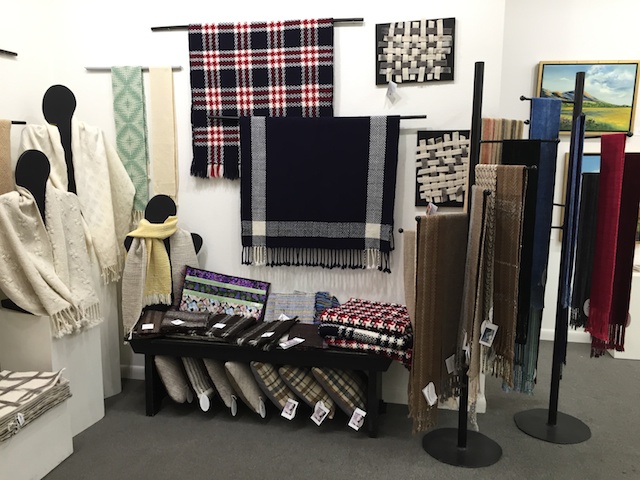
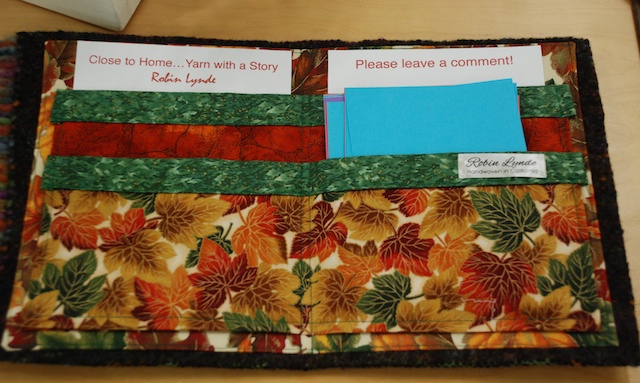
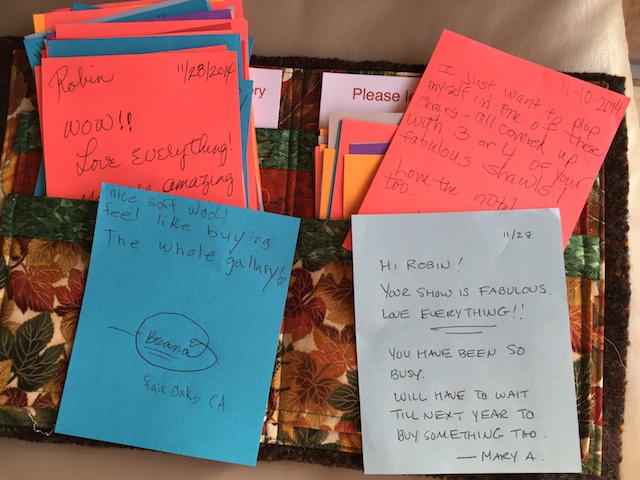





 Why felt this fabric and not use it as is or with only fulling? Felting creates a very dense stable fabric, good for a variety of projects where you don’t need (or want) the fabric to drape. Also, the fibers are so entangled that you can cut this fabric without worrying about it coming apart or fraying.
Why felt this fabric and not use it as is or with only fulling? Felting creates a very dense stable fabric, good for a variety of projects where you don’t need (or want) the fabric to drape. Also, the fibers are so entangled that you can cut this fabric without worrying about it coming apart or fraying. 
 Fabric left over from blankets that I wove years ago.
Fabric left over from blankets that I wove years ago.







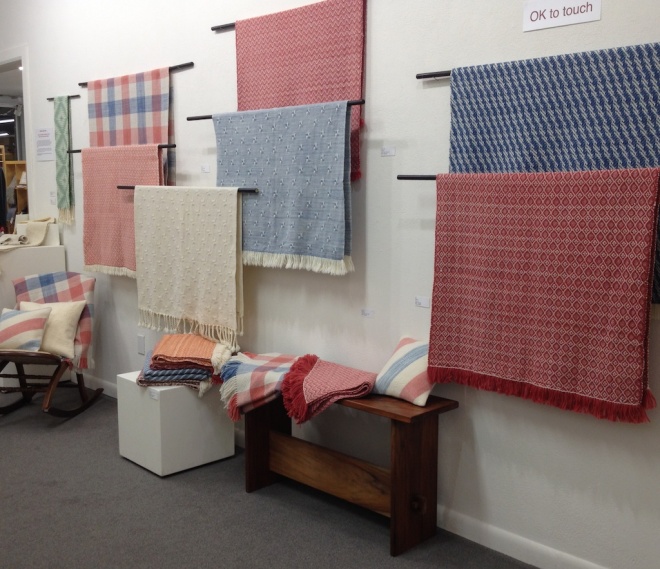 This is one of only two yarns in this show that are not grown in Solano or Marin Counties but I included it because of the variety of colors, naturally dyed, and the quality of the yarn, and it is grown in the Pacific Northwest, which is Closer to Home than many places where wool is grown.
This is one of only two yarns in this show that are not grown in Solano or Marin Counties but I included it because of the variety of colors, naturally dyed, and the quality of the yarn, and it is grown in the Pacific Northwest, which is Closer to Home than many places where wool is grown. 
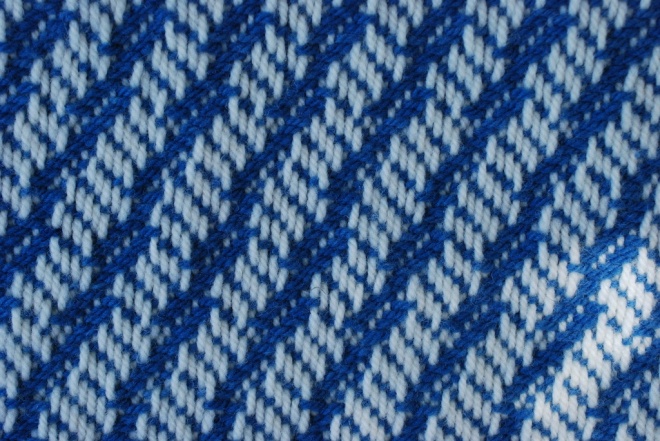
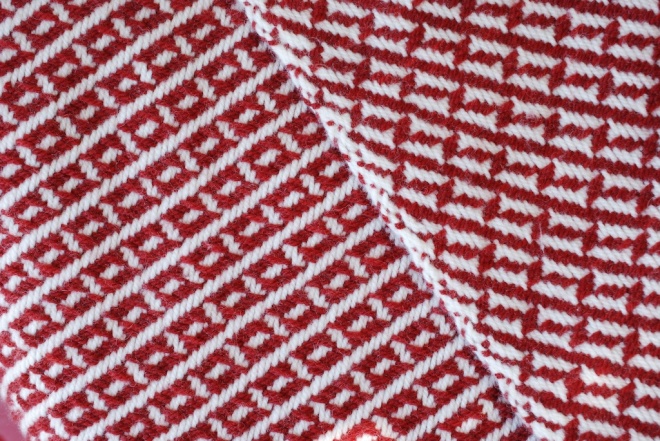
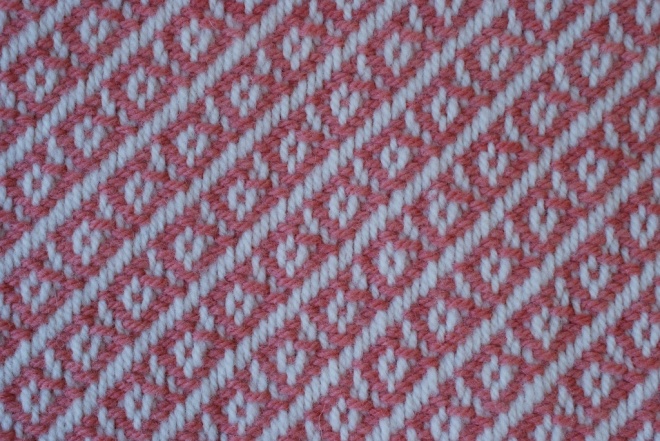
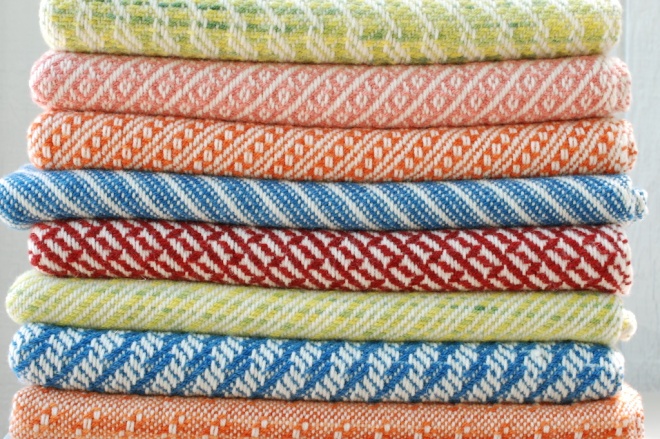 That means that each of the blankets above was woven on the same warp threading in white yarn, but the patterns change by varying the treading and, of course, the color of the weft.
That means that each of the blankets above was woven on the same warp threading in white yarn, but the patterns change by varying the treading and, of course, the color of the weft.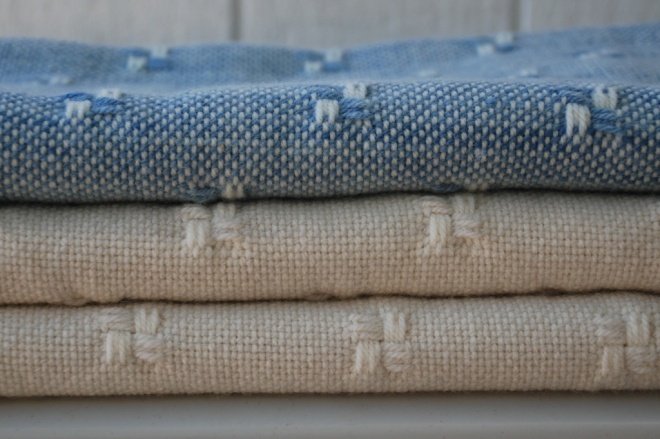
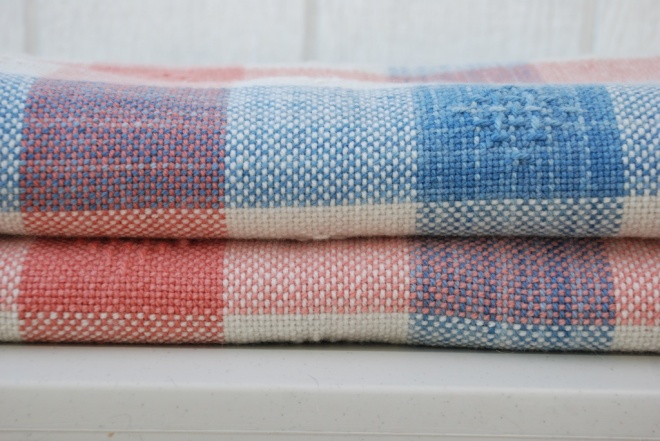
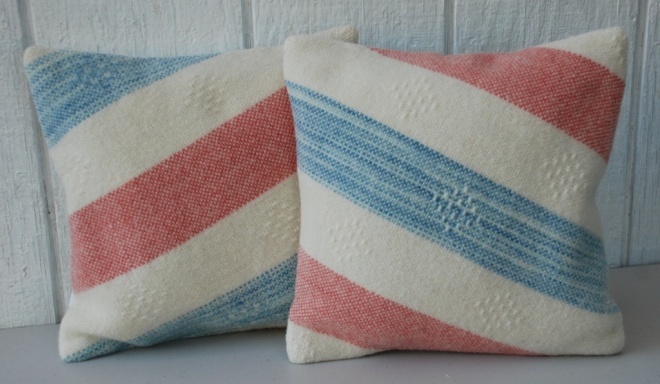 At the end of the warp I just wove in white instead of making it plaid and then I felted the fabric. That made great fabric for pillows.
At the end of the warp I just wove in white instead of making it plaid and then I felted the fabric. That made great fabric for pillows.